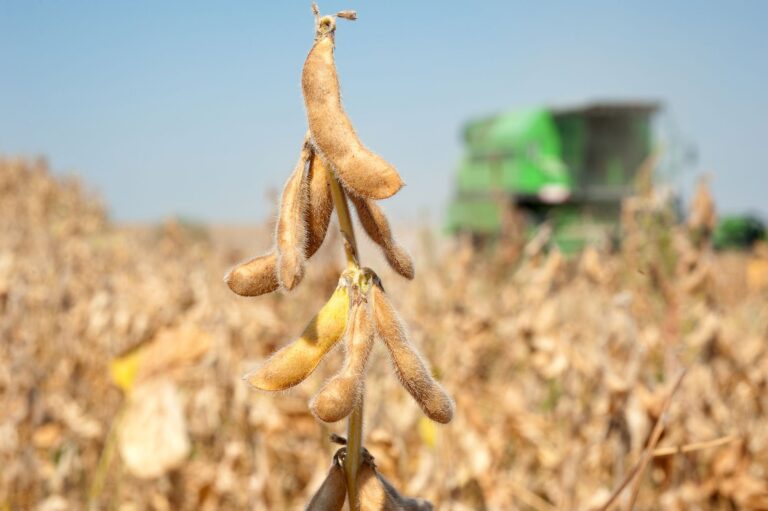Soybeans are once again caught in the crosshairs of a brewing U.S.-China trade war, as escalating tariffs are creating a challenging environment for American farmers. U.S. soybean exports to China now face a 60 percent tariff — double the rate seen during the 2018 trade war — and analysts warn that figure could rise further if retaliatory measures continue between the two economic powers.
The recent flare-up began with President Donald Trump declaring what he called “Liberation Day,” announcing tariffs on over 180 countries, including a sweeping 34 percent tariff on Chinese imports. China quickly responded with its own 34 percent tariffs on U.S. goods. Then on Monday, Trump raised the stakes again, writing on social media: “If China does not withdraw its 34 percent increase above their already long-term trading abuses by tomorrow, April 8th, 2025, the United States will impose ADDITIONAL Tariffs on China of 50 percent, effective April 9th.”
Though trade tensions are climbing, U.S. soybean exports to China have already declined significantly since their peak in 2018. “While it was not unexpected, the resulting cloud of concern following the administration’s tariff announcement is not without fallout — in the form of continued market uncertainty, the threat of lost business to existing soy markets due to potential tariff retaliation, price increases on inputs and more,” the American Soybean Association said. The ASA estimates U.S. soybean producers could lose $5.9 billion annually due to the tariffs.
ASA notes the new tariffs apply to all of the U.S.’s top 10 export markets. “The announcement of 10 percent baseline tariffs on all countries and additional, individualized tariff rates on approximately 60 countries impacts all of U.S. soy’s top 10 export markets. This includes No. 1 export market China. The new duties on China will stack atop the 20 percent tariffs already imposed, bringing the tariff rate on Chinese goods entering the U.S. to 54 percent.”
According to Terrain’s market analysis, China’s reduced demand is driven by long-term stockpiling and economic challenges. “A renewed trade deal would offer false hope. Brazil has been busy feeding China soybeans (supplying nearly three times as much as the U.S. in 2022/23),” Terrain stated. “China met only 60 percent of its prior commitment in the Phase One agreement in 2020/21, is now aligned with Brazil and has been for years, and has stagnant demand.”
Looking for a way forward, ASA is urging the administration to pursue diplomatic solutions. “ASA strongly encourages the administration to swiftly negotiate and address tariff and non-tariff barriers for U.S. agriculture exports,” the group stated. ASA President Caleb Ragland emphasized the importance of turning challenges into new opportunities. “We are hoping that from obstacles can come opportunity and that the administration will swiftly work with the affected countries to create new market access opportunities for U.S. soy and other U.S. products in these markets so these higher tariffs can be removed. That includes pursuing a Phase Two trade agreement with China.”
ASA also supports the administration’s goal of fairer trade through reciprocal tariffs, but cautions against entering a prolonged trade war. “Its reciprocal tariff strategy holds great promise for achieving new market access for U.S. agricultural goods, but ASA strongly encourages the administration to avoid punitive tariffs without negotiations to address tariff and non-tariff barriers. Tit-for-tat trade wars are not beneficial, and U.S. agriculture cannot afford them.”


:max_bytes(150000):strip_icc()/101651813_farm_grain_bin_silo-e2193f5114804686bbea64c89dc0da76.jpg)
:max_bytes(150000):strip_icc()/Luecke3_preview-1f450a0be346443f956da98703bdc439.jpg)
:max_bytes(150000):strip_icc()/JD_SPFHSide_r2g085323_rrd-9fe1ddc407074678b9a14b74c2fdf9e2.jpg)



:max_bytes(150000):strip_icc()/100867484_wheat-ed84884a12c94cf38d0749472f0cf1a3.jpg)
:max_bytes(150000):strip_icc()/54567219870_b2c03840fc_o-9ddb6162d60a477aa91843b1e1051542.jpg)
:max_bytes(150000):strip_icc()/Wetland-Conservation-Indiana-2-2000-8e1d2649f7604bb58dfb1b25c60e46fd.jpg)